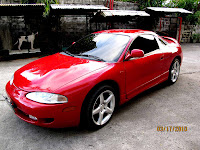 are a lot of factors in order to achieve driving at its best, one of those is the car's Tire pressure, believe it or not this is one of the most important factors, with the wrong tire pressure inflated not only will the driving performance drop but it will also affect the fuel consumption of the vehicle, the required pressure is usually provided by the automaker, it is usually posted with a sticker in the driver sides door jamb or at the back of the gas filler door if not, It might be written somewhere in the car's manual, but if in some cases you happen not to find the standard pressure for the car there is a tip on where you could base the tire pressure from, the engineer of BFGoodrich, Oscar Pereda calls it a "realistic starting point," saying it has never been just right, but is a good place to start. The formula for getting the base tire pressure is:
are a lot of factors in order to achieve driving at its best, one of those is the car's Tire pressure, believe it or not this is one of the most important factors, with the wrong tire pressure inflated not only will the driving performance drop but it will also affect the fuel consumption of the vehicle, the required pressure is usually provided by the automaker, it is usually posted with a sticker in the driver sides door jamb or at the back of the gas filler door if not, It might be written somewhere in the car's manual, but if in some cases you happen not to find the standard pressure for the car there is a tip on where you could base the tire pressure from, the engineer of BFGoodrich, Oscar Pereda calls it a "realistic starting point," saying it has never been just right, but is a good place to start. The formula for getting the base tire pressure is:(Vehicle Weight in lb/100) + 2 psi at the heavier end, if the vehicle suspension and alignment is stock you need to + 2 more psi all around

For example my stock Mitsubishi Eclipse weighs 3,300 lbs.
(3300/100) = 33 psi
Add 2 psi all around = 35 psi
Add 2 psi to heavier end = 37 psi at front
Summary:
With Stock suspension the result is 37 psi front and 35 psi rear.
With Modified suspension, the result is 35 psi front, 33 psi rear.
"There is no 'golden' tire pressure," Oscar said. The optimal setting depends on the individual driver and his preferences. What Oscar said was true but I like to add that there is such thing as the wrong tire pressure base on my experience here are the cases:
 Underinflated Tire - your will experience a smoother ride, but you'll feel the lack of power and steering will be heavier than usual with not much grip while cornering. The After effect is that your tires would wear off much faster and fuel consumption will be higher.
Underinflated Tire - your will experience a smoother ride, but you'll feel the lack of power and steering will be heavier than usual with not much grip while cornering. The After effect is that your tires would wear off much faster and fuel consumption will be higher.Overinflated Tire - You'll experience a bumpier ride, it would feel harsh when you encounter road bumps, but you'd feel the true power of the car, steering would feel lighter (just right), cornering would be sharper, though one would experience lack of grip when pushed hard. The After effect, when you run over a bump with an overinflated tire, chances are high that your tire might be ruined.
Somewhere in the middle is the right tire pressure, it's not hard to figure out, all you need to do is try it out, remember even new tires in perfect condition loses air over time, so you must check from time to time. It may be easier to do so if you keep a tire pressure gauge in your glove compartment rather than the toolbox because it would be much easier for you to find.
Tire pressure Supercars
 |
 |
 |
Top Stories |


0 comments:
Post a Comment